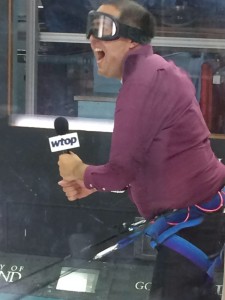COLLEGE PARK, Md. – It isn’t easy standing up to hurricane force winds. At the University of Maryland’s Glenn L. Martin Wind Tunnel, reporters were invited to experience the high winds for themselves.
The machine was a gift to UMD from the Martin Aviation Company after World War II and has been in operation at the Clark School of Engineering since the 1940’s.
“We can generate maximum wind speeds in the test section of 230 miles per hour,” said Jewel Barlow, the wind tunnel’s director. Reporters would only get to see a maximum sustained wind of 115 miles per hour.
The towering turbine with propellers is powered by a two thousand horse power motor.
Barlow said the tunnel is used to do wind tests on many different machines and products. A main customer is the automotive industry, which is required to do wind tests on new model vehicles.
With hurricane season upon us, the machine’s role in developing new products that can hold up to storms is also important. Barlow said this machine can help examine how a product would stand up to a hurricane of any category.
Hurricanes can leave large areas of destruction behind and can’t be thought of as a problem that mainly happens in the more southern states.
“Anywhere on the Gulf Coast to the upper East Coast, we’re all vulnerable,” said Tony Busalacchi, director of UMD’s Earth System Science Interdisciplinary Center. Busalacchi said everyone should pay attention to what is happening in the Atlantic and prepare if a storm threatens.
While the wind tunnel highlights the wind danger from a storm, if a hurricane were to hit the Washington D.C. area, its winds are not the only concern – the rain and storm surge could be equally devastating.
“We have a lot of public infrastructure and national treasures quite frankly, that are at risk,” said Sandra Knight, director of the UMD Center for Disaster Resilience. Knight said learning from past storms when planning for future ones is key.
Watch video of my visit below.








